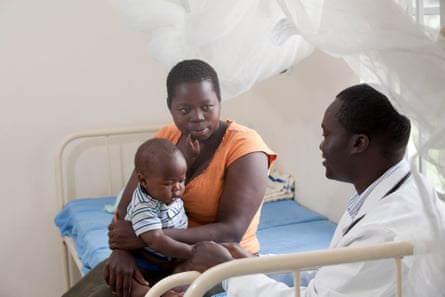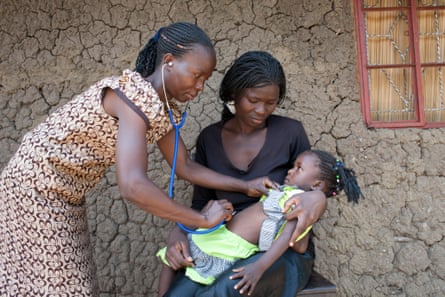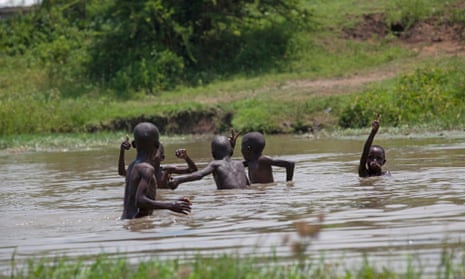Bernard Nato saw six children in his class die of malaria last year. “I took one girl to the clinic when she was dizzy in class. Her parents had given her painkillers but still sent her to school,” says Nato. A few days later the girl died. She was just 11 years old.
Nato teaches in a primary school in Kisumu County, Kenya, which is attached to the Mumias Sugar Plant, the biggest sugar processor in eastern Africa. The swampy fields of sugarcane are ideal for breeding mosquitoes. The close-contact working conditions make for easy transmission of malaria-causing parasites from person to mosquito to person. The company used to regularly fog the plant site with chemicals to reduce mosquito numbers, but stopped last year due to financial problems.
Since ending fogging, consumption of the drugs used to treat malaria has doubled, according to Mumias Sugar’s own figures (from under 150,000 tablets in 2012 to more than 300,000 in 2014). The plant’s clinic provides free treatment for the disease, but it doesn’t always administer tests to make sure the patient is suffering from malaria. Having a lot of people with antimalarials in their bloodstream in endemic areas allows parasites to develop drug resistance, so the medicine loses its power. “It is always best to treat the right disease with the right medication,” says Charles Nelson, chief executive of the Malaria Consortium.
The company offers other prevention methods; but they fall short of international standards. It provides mosquito nets for pregnant women and babies under one year old, but not for all children under five as the World Health Organisation (WHO) recommends. Mumias Sugar’s doctor Naphtali Aroko, says that there’s room for improvement in prevention, but it comes down to the company making enough money to pay for it. “When business performance is high, things like fogging, bush cutting, drainage of stagnant waters and larviciding are done adequately,” he says.
Local economic problems that are hampering prevention, an erratic malaria net distribution system, a risk of growing drug resistance; Mumias Sugar Company is a microcosm of the issues that make malaria the leading cause of death in Kenya.

Martin Edlund, chief executive of US-based NGO Malaria No More, sees tackling the disease as a pressure point that can catalyse broader development issues. “Malaria is the leading cause of missed work in so much of sub-Saharan Africa,” he says. “It’s the leading cause of school absenteeism in most malaria-endemic areas. It’s the leading burden on health systems. If you remove it from the equation you could open up tremendous capacity to tackle other things.”
But in recent years genuine progress has been made in pushing back against this disease, with an estimated 4.3 million lives saved from malaria since 2001, thanks to a colossal global push. According to the WHO, international funding of malaria control has gone from less than $100m in 2000 to $1.97bn in 2013. Perhaps surprisingly, the near twenty-fold increase was part-prompted by the unpopular American leader best known for invading Iraq. “Bush is far and away the most impactful US president in terms of global health,” says Edlund, citing the President’s Malaria Initiative and the President’s Emergency Plan for Aids Relief, both started by Bush. “It probably took a Republican to champion these issues.”
Funding from the UK was also instrumental, as was The Global Fund, the Gates Foundation and the Canadian government. “Ten years ago we said a child dies every 30 seconds from malaria, now we can say that that is true every minute,” says Nelson. “We’ve halved the death rate. The combination of funding and tools made a difference. It is a major achievement; there’s no question about it.” Edlund adds: “It’s one of the biggest successes of the millennium development goals. As the money went up, cases and deaths fell.”
So how can this be sustained? The places where the disease continues to be endemic, where people don’t have preventative measures such as nets or treatment, are the hardest to reach. And the fear is that if global funding and attention turns to something else there will be a lethal resurgence of the disease. “With malaria either you’re making progress or you’re falling back,” says Edlund. “There is no such thing as the status quo. The disease can resurge with devastating consequences: people lose their acquired immunity so you have far more severe cases, more deaths.”
Develop new weapons
New weapons in the form of scientific breakthroughs are needed. The latest test results showed an inoculation vaccine currently in development to be partially effective. Nelson is cautiously excited about this. “It’s not a stand-alone solution and you don’t want people thinking: ‘I’m vaccinated so I can stop sleeping under a bed net’.”
In the meantime surveillance needs to be improved. “When you’ve got a lot of malaria it comes to you. When you haven’t you’ve got to go and find it,” says Nelson. “We need massively improved surveillance to move down the path towards elimination.” Edlund adds: “You need hypersensitive diagnostics that tell us more than our current tests. You have to have pro-active detection where you are going into communities to test and treat people.” That would require tech companies to develop necessary tools and resources.
What if the drugs stop working?
Another crucial part of the fight against malaria is making sure that the drugs used to treat it remain effective. Over the history of malaria, two of the drugs used to treat it have become useless due to mutating parasites. “We need a plan B because the parasites are right now having a conference to work out how to get round the drugs,” one scientist joked at a malaria seminar recently.

Resistance to the current WHO-favoured treatment drug, artemisinin-based combination therapies (ACTs) has already emerged along the Mekong River in southeast Asia. “If you lost ACTs as a tool you would go from 580,000 deaths to several million deaths, instantaneously,” says Edlund. “It would put malaria on top of the deadliest diseases on the planet in a moment’s time.”
Political prioritising
As well as new tools, the fight against malaria needs political leadership from the countries that are struggling with the disease. “One of the significant developments over the last decade is the regions and countries themselves setting their own goals,” says Edlund. “Instead of the WHO alone setting goals for the world.”
The African Leaders Malaria Alliance, launched at the UN general assembly in 2009, is a coalition of 49 heads of state who have committed to ending deaths from malaria with an ambitious target of the end of this year. It holds countries into account via a scorecard that rates countries over a range of metrics - banning monotherapy drugs, which encourage resistance, for example. “You see them sit together at the UN general assembly comparing scorecards,” says Edlund. “That high-level political commitment has huge power.”
Community leaders to tackle misinformation
But as well as top-level political commitment, local leadership is necessary for combatting apathy around the disease. Brenda Chilande, a community health volunteer who works for Mumias Sugar’s corporate social responsibility arm, says that people in her area have a lot of misconceptions about malaria, despite living with it for generations. “They believe malaria is caused by being rained on or chewing sugar cane,” she says. “They also believe that it’s caused by witchcraft.”
In Kisumu county, Agnes Onyango, a 6ft-plus head nurse who nearly died of malaria when she was pregnant with her youngest child, is a dedicated community leader in the fight against the disease. She says that one of the problems they face is improper use of mosquito nets. “Once in a while you will go to someone’s home and they will be using the net for protecting their vegetables from chickens.” Onyango says that people should be fined as a deterrent.
This misinformation fuels the disease and a culture of apathy perpetuates it. “You can be accustomed to something for so long, you stop seeing it as something serious,” says Dr Dorothy Memusi at Kenya’s National Malaria Control Programme in Nairobi. Chilande agrees that there’s complacency around the disease. “The locals don’t perceive it as a serious disease yet it causes death at a very high rate,” she says. “Training local community leaders to fight malaria would give a huge positive impact.”
Unfortunately not all counties in Kenya have someone like Chilande or Onyango spreading knowledge about the disease. “You need really capable, passionate people in the communities doing the frontline work,” says Edlund. “Where that happens you see brilliance, and where that doesn’t happen you see that people really suffer.”
Community leaders, politicians, scientists and NGOs have the ability to prevent schools in Kisumu, and all over the continent, from losing several children a year. “We have tools that can make deaths from malaria a thing of the past,” says Nelson. “We need to get them out there while the resistance is not such that it can’t be beaten. Let’s get the tools out there. Let’s keep the urgency up.”
- Anna Leach’s trip to Kenya was paid for by Novartis AG.
- This article was corrected on 20 May 2015. An earlier version used data from the 2013 World Malaria Report to say that 3.3 million lives are estimated to have been saved from malaria since 2000. The latest 2014 World Malaria Report says it is estimated that globally 4.3 million fewer malaria deaths occurred between 2001 and 2013.
Join our community of development professionals and humanitarians. Follow@GuardianGDP on Twitter.

Comments (…)
Sign in or create your Guardian account to join the discussion